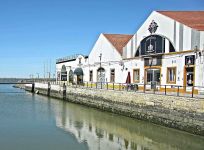Montijo (Portuguese pronunciation: [moˈtiʒu] (listen)) is a municipality in Setubal District in Portugal. Its name was Aldeia Galega do Ribatejo or simply Aldeia Galega until 1930. The population in 2011 was 51,222, in an area of 348.62 km2. The town of Montijo proper had a population of 25,719 in 2001.
It is one of the few municipalities in Portugal without territorial continuity; that is, its component parts are not conjoined. It is located in the Lisbon metropolitan area.
History
Montijo was known as Aldeia Galega until July 6, 1930, in spite of the fact that it was a small town and no longer a village. It was elevated to city status on August 14, 1985.
Paleolithic vestiges of human settlement suggest that the region was occupied into the pre-history. Yet, the first historical references date to the 12th century, in 1186, with the donations of religious and hereditary lands to Paio Peres, that initiated formal occupation.
Initially, the settlement was a constituted of poor hovels, that were villages for fishermen and farmers, but by the 14th century, the area had developed into a sizeable centre, with its own church, dedicated to Sao Sebastiao.
During the reigns of Afonso IV, Pedro and Fernando, Montijo was awarded various privileges that John I later confirmed in 1385. For a long time, the place formed one ecclesiastical parish with neighboring Alcochete, whose seat was in the village of Santa Maria de Sabonha, in the parish of Sao Francisco. On 15 September 1514, Manuel I conceded a foral (charter), which was quickly renewed on 17 January 1515, with Alcochete.
In 1539, the centres separated resulting in administrative autonomy. The grand postmaster, Luis Afonso, established his seat in the south in 1533, due to its geographic conditions and close proximity to Spain and southern Portugal. A year earlier, John III had registered the title to the village of Aldea Galega.
Over the years, many monarch passed through Montijo, such as the future
